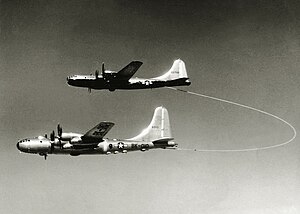Lucky Lady II
| Lucky Lady II | |
|---|---|
 |
|
| Lucky Lady II (46-0010) being refuelled by a KB-29M | |
| Type | Boeing B-50A Superfortress |
| Construction number | 15730 |
| Serial | 46-0010 |
| Owners and operators | United States Air Force |
| In service | 1948-1950 |
| Fate | Badly damaged in accident - Fuselage preserved |
| Preserved at | Planes of Fame Museum in Chino, California |
Lucky Lady II is a United States Air Force Boeing B-50 Superfortress that became the first airplane to circle the world nonstop when it made the journey in 1949, assisted by in-flight refueling. Its total time airborne was 94 hours and 1 minute. After an accident, only the fuselage is preserved. (Lucky Lady II was also the name of a B-17 of the 338th Bomb Squadron, which was shot down near Tielrode, Belgium (Temse), on 30 July 1943.)
The Lucky Lady II was a B-50 of the 43rd Bombardment Group, equipped with 12x 0.50 calibre (12.7mm) machine guns, with an additional fuel tank added in the bomb bay to provide additional range. The aircraft had a double crew with three pilots, with each crew taking a shift of four to six hours on duty and four to six hours off.
The aircraft started its round-the-world trip with a crew of 14 under the command of Capt. James Gallagher at 12:21 PM on February 26, 1949, from Carswell Air Force Base near Fort Worth, Texas, heading east over the Atlantic Ocean.
After flying 23,452 mi (37,742 km), the aircraft passed the control tower back at Carswell AFB on March 2 at 10:22 AM, marking the end of the circumnavigation, and landed there at 10:31 AM after having been in the air for 94 hours and one minute, landing two minutes before the estimated time of arrival calculated at take-off.
En route, the aircraft was refueled four times by KB-29M Superfortresses, near Lajes Air Force Base in the Azores, Dhahran Airfield in Saudi Arabia, Clark Air Force Base in the Philippines, and Hickam Air Force Base in Hawaii, using the soon-to-be obsolete grappled-line looped-hose technique.
...
Wikipedia
